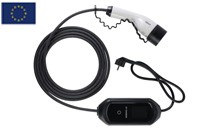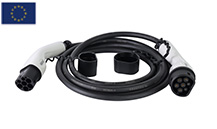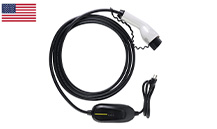Electric cars are becoming more and more recognized, and owners want them to charge as fast as traditional fuel cars. So, what factors are involved in the charging speed of electric cars? Charging speed depends on three main elements: charging station, charging cable and on-board charger. And each charging cable is inseparable from the connector. There are many friends who are curious whether the connector is uniform in each region, and now FAFA-E introduces several common EV charging connectors for you.
Most AC charging stations do not have integrated charging cables, and usually require owners to carry portable chargers for charging, and the connector types are different for different chargers. According to the commonly used areas are roughly divided into American standard connectors, European standard connectors, Chinese national standard connectors, and Japanese standard connectors.
First, we will introduce the connector mainly used in the Americas, J1772 type 1 connector, this AC connector has only five pins, its main disadvantage is that only one phase is allowed, and does not support the built-in auto-lock system.
Currently, the European market is dominated by Type 2 plugs, also known as Type 2 Mennekes plugs, Type 1 and Type 2 plugs use the same J1772 signaling protocol for communication, but differ from Type 1 plugs, Type 2 plugs support a built-in auto-lock system.
China is the world's largest number of electric vehicles, of course, the number of charging stations is also the largest, for EV connectors also have their own set of standards, that is, GB / T standard. The national unification of such plugs also promotes the development of charging infrastructure on one hand.
The above talked about are AC connectors, now let's talk about DC connectors.
I believe we have heard of the CCS combined charging system, so how much do you know about it? This connector is based on the AC type 1 and 2 connector in the bottom to add two pins, in the case of DC charging, the two pins involved in the charging itself, up to be able to carry 350KW of high-power charging. The CCS1 type of connector is more common in the United States, while the CCS2 type of connector is more common in Europe.
The CHAdeMO DC plug, produced by a Japanese manufacturer, has only four pins, and in 2018, the CHAdeMO Association launched a second version of the connector, capable of a maximum charging power of 400 KW.
In China, in addition to AC connectors, DC connectors also have their own set of GB/T standards and are working with CHAdeMO to develop a third generation connector with a charging power of up to 900KW.
As long as the mention of electric vehicles, basically all talk about Tesla. For EV connector is no exception, Tesla has its own set of standards, which allows owners to charge at special Tesla charging stations, while other vehicles can not be charged at Tesla charging stations. To better expand the market, Tesla now offers adapters for other types of plugs as well.
FAFA-E offers CCS1 connectors and CCS2 connectors, please contact us if you need them.






 简体中文
简体中文
